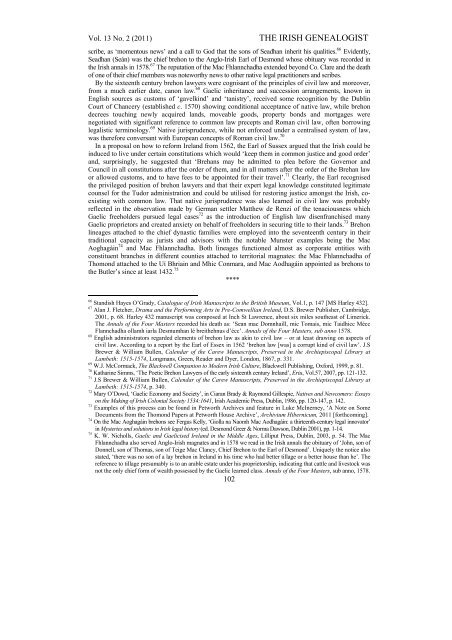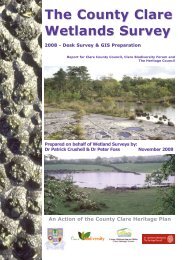A Mac Fhlannchadha Fosterage Document, c.1580 - Clare County ...
A Mac Fhlannchadha Fosterage Document, c.1580 - Clare County ...
A Mac Fhlannchadha Fosterage Document, c.1580 - Clare County ...
Create successful ePaper yourself
Turn your PDF publications into a flip-book with our unique Google optimized e-Paper software.
Vol. 13 No. 2 (2011)THE IRISH GENEALOGISTscribe, as ‘momentous news’ and a call to God that the sons of Seadhan inherit his qualities. 66 Evidently,Seadhan (Seán) was the chief brehon to the Anglo-Irish Earl of Desmond whose obituary was recorded inthe Irish annals in 1578. 67 The reputation of the <strong>Mac</strong> <strong>Fhlannchadha</strong> extended beyond Co. <strong>Clare</strong> and the deathof one of their chief members was noteworthy news to other native legal practitioners and scribes.By the sixteenth century brehon lawyers were cognisant of the principles of civil law and moreover,from a much earlier date, canon law. 68 Gaelic inheritance and succession arrangements, known inEnglish sources as customs of ‘gavelkind’ and ‘tanistry’, received some recognition by the DublinCourt of Chancery (established c. 1570) showing conditional acceptance of native law, while brehondecrees touching newly acquired lands, moveable goods, property bonds and mortgages werenegotiated with significant reference to common law precepts and Roman civil law, often borrowinglegalistic terminology. 69 Native jurisprudence, while not enforced under a centralised system of law,was therefore conversant with European concepts of Roman civil law. 70In a proposal on how to reform Ireland from 1562, the Earl of Sussex argued that the Irish could beinduced to live under certain constitutions which would ‘keep them in common justice and good order’and, surprisingly, he suggested that ‘Brehans may be admitted to plea before the Governor andCouncil in all constitutions after the order of them, and in all matters after the order of the Brehan lawor allowed customs, and to have fees to be appointed for their travel’. 71 Clearly, the Earl recognisedthe privileged position of brehon lawyers and that their expert legal knowledge constituted legitimatecounsel for the Tudor administration and could be utilised for restoring justice amongst the Irish, coexistingwith common law. That native jurisprudence was also learned in civil law was probablyreflected in the observation made by German settler Matthew de Renzi of the tenaciousness whichGaelic freeholders pursued legal cases 72 as the introduction of English law disenfranchised manyGaelic proprietors and created anxiety on behalf of freeholders in securing title to their lands. 73 Brehonlineages attached to the chief dynastic families were employed into the seventeenth century in theirtraditional capacity as jurists and advisors with the notable Munster examples being the <strong>Mac</strong>Aoghagáin 74 and <strong>Mac</strong> <strong>Fhlannchadha</strong>. Both lineages functioned almost as corporate entities withconstituent branches in different counties attached to territorial magnates: the <strong>Mac</strong> <strong>Fhlannchadha</strong> ofThomond attached to the Uí Bhriain and Mhic Conmara, and <strong>Mac</strong> Aodhagáin appointed as brehons tothe Butler’s since at least 1432. 75 ****66 Standish Hayes O’Grady, Catalogue of Irish Manuscripts in the British Museum, Vol.1, p. 147 [MS Harley 432].67 Alan J. Fletcher, Drama and the Performing Arts in Pre-Comwellian Ireland, D.S. Brewer Publisher, Cambridge,2001, p. 68. Harley 432 manuscript was composed at Inch St Lawrence, about six miles southeast of Limerick.The Annals of the Four Masters recorded his death as: ‘Sean mac Domnhaill, mic Tomais, mic Taidhicc MéccFlannchadha ollamh iarla Desmumhan lé breithehnus d’écc’. Annals of the Four Masters, sub anno 1578.68 English administrators regarded elements of brehon law as akin to civil law – or at least drawing on aspects ofcivil law. According to a report by the Earl of Essex in 1562 ‘brehon law [was] a corrupt kind of civil law’. J.SBrewer & William Bullen, Calendar of the Carew Manuscripts, Preserved in the Archiepiscopal Library atLambeth: 1515-1574, Longmans, Green, Reader and Dyer, London, 1867, p. 331.69 W.J. McCormack, The Blackwell Companion to Modern Irish Culture, Blackwell Publishing, Oxford, 1999, p. 81.70 Katharine Simms, ‘The Poetic Brehon Lawyers of the early sixteenth century Ireland’, Eriu, Vol.57, 2007, pp. 121-132.71 J.S Brewer & William Bullen, Calendar of the Carew Manuscripts, Preserved in the Archiepiscopal Library atLambeth: 1515-1574, p. 340.72 Mary O’Dowd, ‘Gaelic Economy and Society’, in Ciaran Brady & Raymond Gillespie, Natives and Newcomers: Essayson the Making of Irish Colonial Society 1534:1641, Irish Academic Press, Dublin, 1986, pp. 120-147, p. 142.73 Examples of this process can be found in Petworth Archives and feature in Luke McInerney, ‘A Note on Some<strong>Document</strong>s from the Thomond Papers at Petworth House Archive’, Archivium Hibernicum, 2011 [forthcoming].74 On the <strong>Mac</strong> Aoghagáin brehons see Fergus Kelly, ‘Giolla na Naomh <strong>Mac</strong> Aodhagáin: a thirteenth-century legal innovator’in Mysteries and solutions in Irish legal history (ed. Desmond Greer & Norma Dawson, Dublin 2001), pp. 1-14.75 K. W. Nicholls, Gaelic and Gaelicised Ireland in the Middle Ages, Lilliput Press, Dublin, 2003, p. 54. The <strong>Mac</strong><strong>Fhlannchadha</strong> also served Anglo-Irish magnates and in 1578 we read in the Irish annals the obituary of ‘John, son ofDonnell, son of Thomas, son of Teige <strong>Mac</strong> Clancy, Chief Brehon to the Earl of Desmond’. Uniquely the notice alsostated, ‘there was no son of a lay brehon in Ireland in his time who had better tillage or a better house than he’. Thereference to tillage presumably is to an arable estate under his proprietorship, indicating that cattle and livestock wasnot the only chief form of wealth possessed by the Gaelic learned class. Annals of the Four Masters, sub anno, 1578.102
















